Tucson Travel Guide
Tucson is surrounded by a ring of mountain ranges with the Santa Catalina Mountains as a backdrop. Found in the Sonoran Desert, it is one of the fastest-growing cities in the country and one of the most attractive holiday destinations in Arizona.
Combining the amenities of a modern metropolis with a small-town atmosphere, the almost constant sunshine and dry desert air provide an oasis where visitors can rest and rejuvenate by the popular health resort.
Its proximity to the Mexican border is evident in its architecture and cuisine, and a long history that has left the city with a dynamic legacy of Spanish, Mexican, American, and Native American influences.
With naturally eroded cliff forms, cacti, bird life, and old cowboy towns in the area, Tucson is also a good central base from which to explore the many natural wonders beyond the city limits. Horseback riding and hiking along the wilderness trails are excellent ways to explore the region.
Nearby attractions include the Saguaro National Park, with the highest concentration in the world of the desert-symbol Saguaro cactus, the Spanish-style Mission San Xavier del Bac, and the first-class Arizona-Sonora Desert Museum that features almost every kind of local desert fauna and flora in an outdoor setting.
The old mining town of Tombstone attracts crowds of tourists to the site of the shootout at the O.K. Corral, the most famous shootout in Wild West history. There's no reason to ignore Tucson's city centre though. With a number of museums, parks, shops, restaurants, and nightspots, Tucson has a lively atmosphere that will keep any visitor thoroughly entertained.
Things to do in Tucson
Much like nearby Phoenix, Tucson is primarily celebrated as a gateway to the glories of the desert. The Arizona-Sonora Desert Museum, Sabino Canyon, the Mission San Xavier del Bac, the Tucson Mountain Park, and Madera Canyon are very close by.
The incredible caves in the Colossal Cave Mountain Park and Kartchner Caverns State Park provide spectacular scenery for hikers and spelunkers. The iconic cowboy town of Tombstone is also in the area, attracting travellers keen to experience the rough charm of the Wild West.
Within the city of Tucson, popular stops on the tourist trail include the Tucson Botanical Gardens, the Tucson Rodeo Parade Museum (between January and March), and a number of interesting art museums and galleries, such as the University of Arizona Art Museum and the Degrazia Gallery in the Sun.
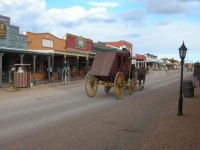
Tombstone
Tombstone is probably the most famous town in the Wild West, attracting thousands of tourists with its old Western-style buildings, saloons, stagecoach rides, gunslingers, dusty streets, and shootout re-enactments. Many Hollywood movies have been shot here against the rugged mountain backdrop. Originally a silver boomtown in 1877, it rose to notoriety in 1881 when lawmen Wyatt Earp, his two brothers, and Doc Holliday confronted a band of outlaws in a gunfight. This event has come to epitomise the spirit of the Wild West and the star attraction of the town is the O.K. Corral, one of southern Arizona's most visited tourist sites. There is a staged 30-second shootout each day at 2pm, and exhibits relating to the event inside the corral. The Tombstone Courthouse State Historic Park features an old courtroom where several renowned trials took place, as well as some excellent exhibits, including alternative versions of the O.K. Corral shootout and a museum dedicated to the Tombstone Epitaph, the oldest newspaper in Arizona. Although a classic tourist-trap town, with souvenir shops and restaurants galore, many people love the Wild West atmosphere and the rugged setting of Tombstone, and relish the chance to play cowboy for a day.
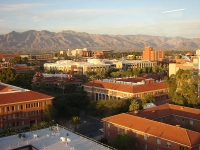
University of Arizona Art Museum
The University of Arizona Art Museum is situated on campus as part of the Edward J. Gallagher Memorial Collection. It is home to an impressive permanent collection including works by Jackson Pollock, Franz Kline, and Mark Rothko. The museum houses the C. Leonard Pfeiffer Collection of American paintings and the Samuel H. Kress Collection of European works, from the 14th to the 19th century. Temporary exhibitions are also hosted by the museum so travellers should check the official website to see what's available during their visit. The University of Arizona campus is also the location of the Center for Creative Photography, displaying various works by leading artists such as Edward Weston and Ansel Adams. Lovers of art in all forms will find a visit rewarding while in Tucson.
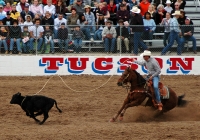
Tucson Rodeo Parade Museum
At the Tucson Rodeo Parade Museum, pioneer artefacts and a recreated Western Main Street represent what Tucson looked like, and what it had to offer in the way of businesses and services, back in the old days of the Wild West. The museum also has an inventory of about 150 vehicles, with everything from small buggies to wagons and coaches on display. The museum hosts the Tucson Rodeo Parade each February, which is great fun for those in the area at the time. Outside of Rodeo Week, the museum is sadly only open between January and March, with guided tours available daily at 10am and 1pm. There are hopes to extend the opening season once sufficient funds have been raised.
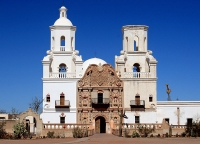
The Mission San Xavier del Bac
This historic Spanish mission in the Tohono O'odham Nation Reservation is located 10 miles (16km) south of the city (a 20-minute drive) and was founded by Father Kino in the 1660s. The present church, a remarkable building, dates back to the 18th century and remains the oldest intact European structure in Arizona, housing a number of impressive artefacts and murals. It is a National Historic Landmark and is still an active place of worship, where visitors can attend services should they please. Travellers should check the website for a service schedule and note that the church may be closed to sightseeing tourists during times of worship. The mission has a small museum, which showcases artefacts and multimedia presentations on its history.
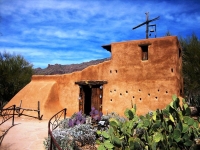
DeGrazia Gallery in the Sun
The DeGrazia Gallery in the Sun is an iconic Tucson landmark located at the base of the Santa Catalina Mountains. Established by the famous artist, Ettore DeGrazia, the property is listed on the National Register of Historic Places and features a museum of DeGrazia's work and an adobe chapel, called the Mission in the Sun, as well as striking murals, gardens, and the artist's home and grave site. Apart from the works displayed in the gallery, the property is strewn with sculptures and art installations by the artist renowned for having captured the spirit of the Southwest. Free public tours are available, but must be scheduled in advance.
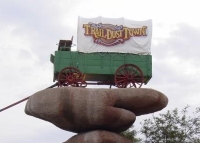
Trail Dust Town
Trail Dust Town is built on the site of a 1950s Western movie set and is home to a vintage 1920s Fiesta del Presidio carousel and a museum dedicated to Western cavalry and dragoon military units. Designed as a replica of a 19th-century Western town, it has Old West souvenir shops, galleries, and restaurants, as well as a custom leather store, wooden sidewalks, a central plaza, shooting gallery, and a C.P. Huntington train. Hosting Wild West stunt shows and an annual cowboy show in late February, Trail Dust Town is a great place to visit, especially if you are travelling with kids.
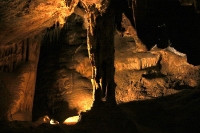
Colossal Cave Mountain Park
In 1923, the first proper tours of Colossal Cave were conducted using ropes and lanterns. Today, more advanced and comfortable options are offered. The cave is considered dry or dormant, no longer producing crystal formations due to a lack of water. The preserved stalagmites, stalactites, and flowstone create a cavern of wonder visitors enjoy during guided tours which take just under an hour. The cave itself is only part of the attraction, as the Mountain Park is blessed with a variety of wildlife and some glorious landscapes. Western-themed horseback tours are a popular way to explore the park.
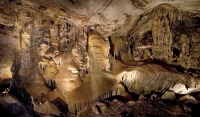
Kartchner Caverns State Park
Kartchner Caverns State Park is home to one of the great natural wonders of the American west. There is no known record of the huge living cave being seen before the 1970s and the pristine conditions within have been carefully preserved. A remarkable feature of this cave is that it's a 'wet' or 'living' cave; the calcite formations are still growing and display a stunning variety of multi-coloured cave formations. Two different tours of the caves are available and there is a visitor's centre which details the history and geology of the caverns with interesting exhibits. Tours take between 90 minutes and two hours. Photography is not allowed in the caves but there are postcards available.
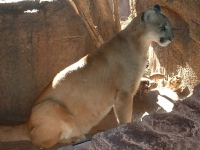
Arizona-Sonora Desert Museum
This world-renowned museum is more like a zoo, with the majority of the exhibitions outside showcasing the surrounding desert's creatures in their natural habitats. Exhibits include mountain lions, otters, coyotes, bighorn sheep, lizards, and a walk-in aviary. Located in the Sonoran Desert, the setting of the museum also offers awesome views of the surrounding mountain ranges, which visitors can enjoy while touring the botanical garden, natural history museum, art gallery, and aquarium. The gift shop has an excellent selection of Sonoran desert souvenirs. The interactive museum is a must for any visitor staying in Tucson for more than just one day, and kids will love seeing the animals and experiencing the desert landscapes.
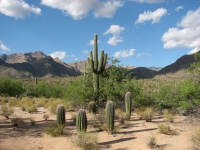
Sabino Canyon
Of the many natural attractions in the Tucson vicinity, Sabino Canyon is one of the most popular. This gaping divide in the Santa Catalina Mountains is the site where ancient Hohokam people constructed irrigation dams while mammoths still roamed the area. After a six-mile (9.6km) hike, visitors can enjoy swimming in the crystal clear pools at Seven Falls or, when the weather is a little too hot for hiking, they can take a ride on the Sabino Canyon Tram, which takes a 45-minute tour with nine stops along the canyon. The canyon is a natural oasis in the desert and is home to a rich variety of wildlife, as well as beautiful landscapes.
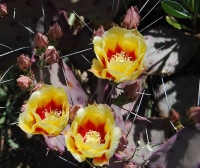
Tucson Botanical Gardens
The Tucson Botanical Gardens is a major attraction, and not just for the rich collection of cacti and desert wildflowers. An educational walk highlights the history of the native Tohono O'odham Indians and the work local scientists have done to preserve native seeds. Visitors should be sure to see the traditional Mexican-American neighbourhood garden (Nuestro Jardin), and relax on the shaded restaurant patio. The gardens are open seven days a week, all year, and provide a pleasant sample of the desert vegetation of Arizona as well as a taste of the indigenous culture. There are about 17 speciality gardens, as well as rotating exhibitions, and tours of the gardens are available.
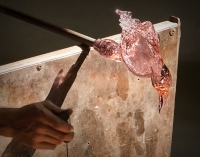
Philabaum Glass
Tom Philabaum is well known as one of America's foremost glass artists, with exhibits throughout the Western world. His gallery showcases and justifies this reputation with examples of his own work, also exhibiting over 100 other nationally and internationally celebrated glass artists. Aside from viewing the extraordinary exhibits, visitors are also welcome to watch glassblowing in progress and learn more about the craft in the studio. The gallery has been a great favourite on the Tucson art scene for more than 30 years and travellers interested in art will relish a visit to this creative gallery. It is also an exciting place to buy souvenirs.
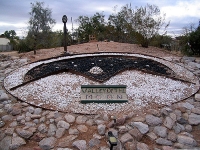
Valley of the Moon
The Valley of the Moon was designed to stimulate the imagination of children and to awaken creativity and spirituality in all visitors. Visitors can delve into a fantasy land in the desert, with historic Western sites in a magical setting, created by George Phar Legler in the 1920s. Mineralised rock cliffs, caves, pools, and garden miniatures have merged with tropic and desert flora to make what Legler called the 'Fantasy Touch of Three', referring to the worlds of Edgar Allen Poe, Lewis Carroll, and Robert Louis Stevenson. There are tours, shows, and a gift shop on site. The Valley of the Moon also hosts events ranging from weddings to concerts to yoga retreats. Although this unusual attraction may not be to everybody's taste, those travelling with children will no doubt find a visit rewarding.
Getting Around
Tucson has an extensive public bus system operated by Sun Tran. The city also has a large network of bike routes and with its flat terrain is considered bike-friendly, but the heat makes this option less attractive in the summer months. The roads are easy to follow and driving is relatively pleasant, though the streets are congested at certain times of day. As with most cities in the US, things are fairly spread out and many tourists find it most convenient to hire a car, especially as so many of Tucson's top attractions are just outside the city.
Tucson Climate and Weather
Tucson experiences a desert climate, meaning that temperatures are high and rainfall is too low to sustain much vegetation at all. There are two major seasons, summer and winter, with three minor shoulder seasons: autumn, spring, and the monsoon.
Early summer, particularly June, enjoys low humidity and clear skies, with daytime highs reaching above 100F (38C) and average overnight temperatures ranging between 66F (19C) and 85F (29C). In July and August, temperatures are much the same but it is much more humid and rain is very common, as this is the monsoon season.
Flash floods are possible in late summer. Winters, between December and February, are mild, with average daytime highs between 40F (4C) and 68F (20C). The milder weather of winter is usually most pleasant for tourists.
United States of America travel info
Electricity
The electrical current is 120 volts, 60Hz. Plugs are mainly the type with two flat pins, though three-pin plugs (two flat parallel pins and a rounded pin) are also widely used. European appliances without dual-voltage capabilities will require an adapter.
Language
English is the most common language spoken but Spanish is often heard in the south-western states.
Money
The official currency is the US Dollar (USD), which is divided into 100 cents. Only major banks exchange foreign currency. ATMs are widespread and credit cards are widely accepted; Apple Pay and Google Pay are very popular. Banking hours are Monday to Friday 9am to 3pm.
Tipping
A 15 percent tip is expected by taxi drivers, bartenders, hairdressers and waiters, but travellers shouldn't tip in fast-food or self-service restaurants. In expensive restaurants or for large parties, the tip should be 20 percent of the bill. It's normal to tip staff such as valets and porters in hotels; this is discretionary, although a minimum of $5 is expected. Most services are customarily tipped if the service is good.
Health
There are no specific health risks associated with travel within the USA. Medical facilities are excellent, but expensive. Only emergencies are treated without prior payment and treatment can be refused without evidence of insurance or proof of funds. Good medical insurance is essential.
Safety
Travel within the United States is generally trouble-free, though travellers should be aware that the US shares with the rest of the world an increased threat from terrorist incidents. Security has been heightened, particularly at airports. Restrictions on hand luggage apply and travellers are advised to check on the latest situation with airlines in advance. Travellers should also be alert to the dangers of car and street crime in cities and should use common sense and take basic precautions. Hurricanes are common between June and November, putting the southern USA, including the Gulf Coast and the eastern US at risk. There's a risk of wildfires in many dry areas in the US, particularly on the West Coast from March to November.
Local customs
Laws vary from state to state, including speed limit, fines and punishment. The age at which alcohol may be legally bought and consumed is 21 years.
Doing business
In such a large country, filled with so many diverse groups, business practices may differ according to each state, though rarely to any large degree. The East Coast is traditionally more formal than the West Coast, though in states such as California, dress code and conservative appearance are as common as they would be in New York. Punctuality is important throughout the country and it's considered rude to be late for a meeting. Gift-giving is uncommon as it may be construed as bribery. Appropriate titles (Mr, Mrs, Ms) are used upon introduction and until otherwise stated. Americans favour politeness and greetings of 'Hello' and 'How are you?' are often expressed with sincerity. Business hours may vary in each state, but an 8am start and 5pm finish Monday to Friday is the most common with an hour over lunch.
Status and age are not necessarily indicative of seniority, nor do they carry much weight in themselves. Those doing business in the States should be mindful of this fact; foreigners should never make assumptions about someone's position or rank. Best practice is to be respectful to all parties. That said, the US upholds a hierarchal business structure in which 'the boss' is the ultimate decision-maker. Senior leaders have the power of the last word, and can go against the grain just as easily as they can follow popular opinion. Foreigners should concentrate on winning over this individual, even if the greater group seems unsupportive. Americans value a direct style of communication. In this fast-paced, consumer culture 'time is money', and small-talk is viewed as unnecessary and wasteful. It's best for foreigners to get to the point quickly, speak about issues in a frank and open manner, and to avoid taking offence if someone questions or challenges them outright.
Duty free
Travellers to the United States who are returning residents of the country do not have to pay duty on articles purchased abroad to the value of $800 provided their stay was longer than 48 hours and their duty-free allowance was not used in the 30-day period prior. For passengers arriving from Samoa, Guam and the U.S. Virgin Islands, a duty-free allowance of $1,600 is allowed. The following items are included in this: 50 cigarettes and 10 cigars and 150 millilitres (5 fl. oz.) of alcoholic beverages or 150 millilitres (5 fl. oz.) of perfume containing alcohol. Restrictions may apply to goods from Cuba, Iran, North Korea, Burma (Myanmar), Angola, Liberia and Sudan. It is prohibited to import Cuban cigars from any country.
Travellers to the United States who are non-residents do not have to pay duty on the following items: 50 cigars or 200 cigarettes and gifts to the value of $100 provided their stay in the USA is not less than 72 hours and that the allowance has not been used in the preceding six-month period.
Prohibited items for residents and non-residents include meat or meat products, poultry, narcotics, absinthe, plants, seeds, vegetables, fruits, soil, live insects and other living plants or animal pests. Fish is prohibited unless it carries disease-free certification. Wildlife and animals or their by-products carry restrictions. Dairy products and eggs from specified countries are not allowed. Firearms and ammunition are not allowed without the necessary license and permit.
Communications
The international country dialling code for the United States is +1. Mobile networks cover most of the country, especially all urban areas; travellers can purchase local prepaid SIM cards for unlocked phones or use eSIMs if their cellular providers support it on their networks. WiFi is widely available.
Passport & Visa
It is highly recommended that travellers' passports have at least six months' validity remaining after the intended date of departure from them travel destination. A visa is required for short visits unless travellers qualify for entry under the Visa Waiver Program.
The Visa Waiver Program (VWP) enables citizens of certain countries to travel to the US for a stay of up to 90 days without a visa. Visitors under the VWP need a valid Electronic System for Travel Authorization (ESTA), which allows the US government to screen all visitors before travel. Visitors entering the country under the VWP must have a machine-readable passport (MRP) that has a barcode on the photo page. Travellers under the VWP must have passports that include biometrics if they wish to enter the country without a visa, which means that passports must contain unique personal data such as fingerprints or iris details. All passports must contain a digital photo image in order to travel visa-free. All visitors to the USA have a photograph and two fingerprints taken by an inkless scanner on arrival, including those travelling visa-free under the VWP.
As part of the Western Hemisphere Travel Initiative (WHTI), all travellers travelling between the United States and Canada, Mexico, Bermuda, and the Caribbean region are required to present a passport or other valid travel document to enter or re-enter the United States. If departing from the USA, a valid passport is required by immigration authorities. Immigration officials often apply different rules to those stated by travel agents and official sources.
Entry requirements
US citizens require passports.
UK nationals require a passport valid for duration of stay. Most passport holders can get an Electronic System for Travel Authorisation (ESTA) through the Visa Waiver Programme, which allows travel to the US for up to 90 days. The VWP includes tourism, certain types of business visit and transit to another country.
The most important requirement on entering the U.S. is providing proof of Canadian citizenship. A valid Canadian passport is the best document to prove Canadian citizenship and the right to return to Canada. However, several other documents can serve, depending on the mode of transport. Generally, Canadian citizens do not require visitor, business, transit or other visas to enter the United States from Canada, though there are some exceptions.
Passports must be valid for the period of intended stay. If visiting the US for fewer than 90 days, Australian nationals may be eligible to apply for an Electronic System for Travel Authorization (ESTA), and enter under the Visa Waiver Program (VWP).
South Africans must hold a passport valid for duration of stay. A visa is required.
Passports must be valid for duration of stay. Irish nationals can get an Electronic System for Travel Authorisation (ESTA) under the Visa Waiver Programme for entry into the United States.
Passports must be valid for duration of stay. New Zealand nationals can get an Electronic System for Travel Authorisation (ESTA) under the Visa Waiver Programme for entry into the United States.
Useful contacts
United States Tourist Office: www.usatourist.com
911 (General)Embassies / consulates in other countries
United States Embassy, London, United Kingdom: +44 20 7499 9000.
United States Embassy, Ottawa, Canada: +1 613 688 5335.
United States Embassy, Canberra, Australia: +61 2 6214 5600.
United States Embassy, Pretoria, South Africa: +27 12 431 4000.
United States Embassy, Dublin, Ireland: +353 1 668 8777.
United States Embassy, Wellington, New Zealand: +64 4 462 6000.
Embassies / consulates in United States of America
British Embassy, Washington DC: +1 202 588 6500.
Canadian Embassy, Washington DC: +1 202 682 1740.
Australian Embassy, Washington DC: +1 202 797 3000.
South African Embassy, Washington DC: +1 202 232 4400.
Irish Embassy, Washington DC: +1 202 462 3939.
New Zealand Embassy, Washington DC: +1 202 328 4800.



